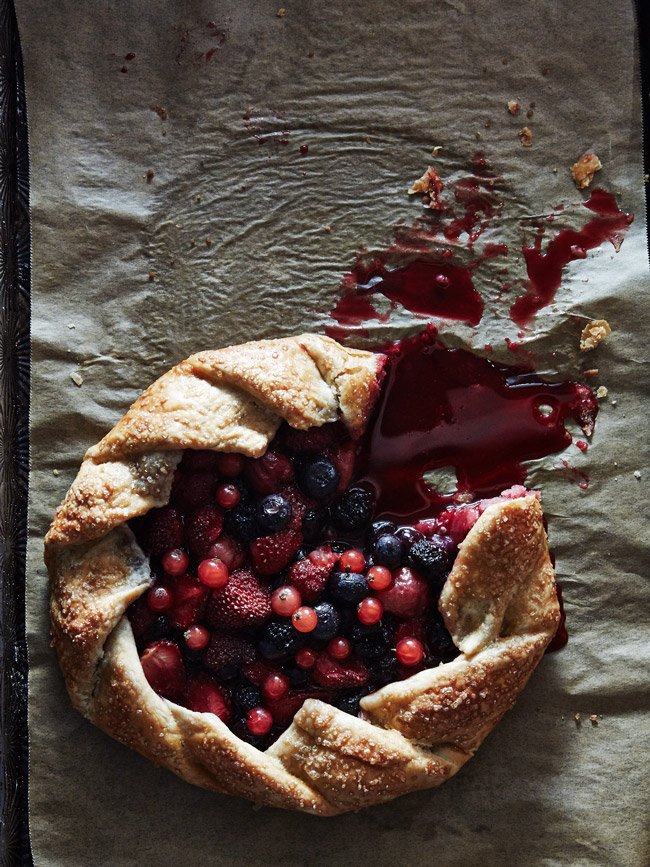When we moved into our apartment in San Francisco, we bought a giant bookshelf and filled it to the brim with books. Over time, the overflow started lying in stacks in front, and by the time we moved out, we had so many books that Chris ended up having to donate most of the collection. The rest we stored at my parents’ house, boxes and boxes full. It wasn’t so much that I had a book-buying problem. Chris is just helpless at the sight of used bookstores. They are treasure troves to him, much in the same way good grocery stores—the kinds with bulk bins and small-batch anythings—are to me.
Moving to New York seemed like a good chance to wipe the slate clean. Chris curated a small collection of his most beloved books and shipped them to our new apartment in Brooklyn. Except, over time, as he discovered his favorite bookstores in New York, his modest collection grew and grew. We expanded to THREE bookshelves, started double-layering books on each shelf, and then the stacks started up again. The book area even started its own collection: of dust bunnies. It was a mess.
The thing about collections is, the collector starts to lose sight of the point of the collection. Presumably you start one because you love whatever it is you’re collecting, but the more you own of something, the less attention each individual item gets. We’re so inoculated with the idea that more is better, but perhaps real merit lies in realizing when enough is enough.
And so, when furnishing our new, smaller apartment, we decided to limit ourselves to one regular-sized bookshelf which demanded that we downsize our collection yet again. Chris committed himself to maintaining an equilibrium of books which he’s kept up to this day, and since then, has discovered clarity, focus, and a lightening of the spirit. Which sounds kind of hippie dippie bordering on hokey, but is not, I promise.
On my part, I decided to part with quite a few cookbooks. Back to the basics, if you will. Or just the favorites. And I too find such pleasure in lingering over what’s left of my collection. Each and every book is an absolute gem. The recipe for the crust of these mixed berry galettes are from Kim Boyce’s Good to the Grain, a classic to me and one that will always have a place on my shelf.


Happy 4th, y’all. Also, Chris and I went to Iceland! If you’re interested, I created an album on Flickr.
RYE GALETTE CRUST for MIXED BERRIES GALETTES
From Good to the Grain by Kim Boyce
Makes 2 9-inch tarts
This recipe is for the crust only. Filling-wise, I tossed about 2 cups of mixed berries with 3 T sugar, a liberal pinch of cinnamon, and a dash vanilla extract (about 1/4 t). Next time, I would add either flour or corn starch to thicken the juices because they leaked all over the place and made the baking sheet look like a crime scene. Also, if you too use redcurrants, add them after baking. And I’d omit the gooseberries altogether.
Ingredients:
- 3/4 cup ice water
- 1 cup rye flour
- 1 cup all-purpose flour
- 1 T sugar
- 1 t salt
- 1-1/2 sticks (12 T) cold unsalted butter
- 1 t apple cider vinegar
Directions:
Sift the flours, sugar, and salt in a large bowl. Cut the butter into 1/2-inch pieces and add them to the dry mixture. Working quickly, rub the butter between your fingers, breaking it into smaller chunks. When the chunks are sizes ranging from peas to hazelnuts, add the vinegar and 8 T ice water. Mix the ingredients with your hands until you can squeeze them into a shaggy lump (add water 1 T at a time if it’s not coming together). Wrap the dough in plastic wrap and place in fridge for at least 1 hour.
Unwrap the dough onto a floured surface. Pat the dough into a rough square, then, using a rolling pin, roll the dough to a rectangle about 8-1/2 by 11 inches. Resist the urge to add extra flour or water. Fold the rectangle as you would a letter, into thirds, with the seam ending on the left. Rotate the dough 90 degrees clockwise so that the seam faces the top. Roll the dough into another 8-1/2 by 11-inch rectangle and repeat the folding and rotation. Roll it out once again, then, after folding, wrap the dough tightly in plastic wrap. Chill for at least an hour before use.
You’ll cut the dough in half when you’re ready to bake, resulting in two galettes, capisce?


